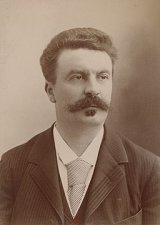The Mask
"The Mask" is a short story by Guy de Maupassant that explores themes of identity, deception, and the duality of human nature. The narrative follows a woman who, upon attending a masquerade ball, dons a mask to conceal her true identity. As she interacts with others in this festive environment, she reflects on the facades people maintain in society and the hidden truths behind appearances. Maupassant expertly captures the tension between the superficial and the authentic, ultimately revealing profound insights into the human condition. The story highlights how masks—literal and metaphorical—can both liberate and imprison individuals.
There was a masquerade ball at the Elysee-Montmartre that evening. It was the 'Mi-Careme', and the crowds were pouring into the brightly lighted passage which leads to the dance ball, like water flowing through the open lock of a canal. The loud call of the orchestra, bursting like a storm of sound, shook the rafters, swelled through the whole neighborhood and awoke, in the streets and in the depths of the houses, an irresistible desire to jump, to get warm, to have fun, which slumbers within each human animal. The patrons came from every quarter of Paris; there were people of all classes who love noisy pleasures, a little low and tinged with debauch. There were clerks and girls—girls of every description, some wearing common cotton, some the finest batiste; rich girls, old and covered with diamonds, and poor girls of sixteen, full of the desire to revel, to belong to men, to spend money. Elegant black evening suits, in search of fresh or faded but appetizing novelty, wandering through the excited crowds, looking, searching, while the masqueraders seemed moved above all by the desire for amusement. Already the far-famed quadrilles had attracted around them a curious crowd. The moving hedge which encircled the four dancers swayed in and out like a snake, sometimes nearer and sometimes farther away, according to the motions of the performers. The two women, whose lower limbs seemed to be attached to their bodies by rubber springs, were making wonderful and surprising motions with their legs. Their partners hopped and skipped about, waving their arms about. One could imagine their panting breath beneath their masks. One of them, who had taken his place in the most famous quadrille, as substitute for an absent celebrity, the handsome “Songe-au-Gosse,” was trying to keep up with the tireless “Arete-de-Veau” and was making strange fancy steps which aroused the joy and sarcasm of the audience. He was thin, dressed like a dandy, with a pretty varnished mask on his face. It had a curly blond mustache and a wavy wig. He looked like a wax figure from the Musee Grevin, like a strange and fantastic caricature of the charming young man of fashion plates, and he danced with visible effort, clumsily, with a comical impetuosity. He appeared rusty beside the others when he tried to imitate their gambols: he seemed overcome by rheumatism, as heavy as a great Dane playing with greyhounds. Mocking bravos encouraged him. And he, carried away with enthusiasm, jigged about with such frenzy that suddenly, carried away by a wild spurt, he pitched head foremost into the living wall formed by the audience, which opened up before him to allow him to pass, then closed around the inanimate body of the dancer, stretched out on his face. Some men picked him up and carried him away, calling for a doctor. A gentleman stepped forward, young and elegant, in well-fitting evening clothes, with large pearl studs. “I am a professor of the Faculty of Medicine,” he said in a modest voice. He was allowed to pass, and he entered a small room full of little cardboard boxes, where the still lifeless dancer had been stretched out on some chairs. The doctor at first wished to take off the mask, and he noticed that it was attached in a complicated manner, with a perfect network of small metal wires which cleverly bound it to his wig and covered the whole head. Even the neck was imprisoned in a false skin which continued the chin and was painted the color of flesh, being attached to the collar of the shirt. All this had to be cut with strong scissors. When the physician had slit open this surprising arrangement, from the shoulder to the temple, he opened this armor and found the face of an old man, worn out, thin and wrinkled. The surprise among those who had brought in this seemingly young dancer was so great that no one laughed, no one said a word. All were watching this sad face as he lay on the straw chairs, his eyes closed, his face covered with white hair, some long, falling from the forehead over the face, others short, growing around the face and the chin, and beside this poor head, that pretty little, neat varnished, smiling mask. The man regained consciousness after being inanimate for a long time, but he still seemed to be so weak and sick that the physician feared some dangerous complication. He asked: “Where do you live?” The old dancer seemed to be making an effort to remember, and then he mentioned the name of the street, which no one knew. He was asked for more definite information about the neighborhood. He answered with a great slowness, indecision and difficulty, which revealed his upset state of mind. The physician continued: “I will take you home myself.” Curiosity had overcome him to find out who this strange dancer, this phenomenal jumper might be. Soon the two rolled away in a cab to the other side of Montmartre. They stopped before a high building of poor appearance. They went up a winding staircase. The doctor held to the banister, which was so grimy that the hand stuck to it, and he supported the dizzy old man, whose forces were beginning to return. They stopped at the fourth floor. The door at which they had knocked was opened by an old woman, neat looking, with a white nightcap enclosing a thin face with sharp features, one of those good, rough faces of a hard-working and faithful woman. She cried out: “For goodness sake! What's the matter?” He told her the whole affair in a few words. She became reassured and even calmed the physician himself by telling him that the same thing had happened many times. She said: “He must be put to bed, monsieur, that is all. Let him sleep and tomorrow he will be all right.” The doctor continued: “But he can hardly speak.” “Oh! that's just a little drink, nothing more; he has eaten no dinner, in order to be nimble, and then he took a few absinthes in order to work himself up to the proper pitch. You see, drink gives strength to his legs, but it stops his thoughts and words. He is too old to dance as he does. Really, his lack of common sense is enough to drive one mad!” The doctor, surprised, insisted: “But why does he dance like that at his age?” She shrugged her shoulders and turned red from the anger which was slowly rising within her and she cried out: “Ah! yes, why? So that the people will think him young under his mask; so that the women will still take him for a young dandy and whisper nasty things into his ears; so that he can rub up against all their dirty skins, with their perfumes and powders and cosmetics. Ah! it's a fine business! What a life I have had for the last forty years! But we must first get him to bed, so that he may have no ill effects. Would you mind helping me? When he is like that I can't do anything with him alone.” The old man was sitting on his bed, with a tipsy look, his long white hair falling over his face. His companion looked at him with tender yet indignant eyes. She continued: “Just see the fine head he has for his age, and yet he has to go and disguise himself in order to make people think that he is young. It's a perfect shame! Really, he has a fine head, monsieur! Wait, I'll show it to you before putting him to bed.”
Translation
Translate and read this book in other languages:
Select another language:
- - Select -
- 简体中文 (Chinese - Simplified)
- 繁體中文 (Chinese - Traditional)
- Español (Spanish)
- Esperanto (Esperanto)
- 日本語 (Japanese)
- Português (Portuguese)
- Deutsch (German)
- العربية (Arabic)
- Français (French)
- Русский (Russian)
- ಕನ್ನಡ (Kannada)
- 한국어 (Korean)
- עברית (Hebrew)
- Gaeilge (Irish)
- Українська (Ukrainian)
- اردو (Urdu)
- Magyar (Hungarian)
- मानक हिन्दी (Hindi)
- Indonesia (Indonesian)
- Italiano (Italian)
- தமிழ் (Tamil)
- Türkçe (Turkish)
- తెలుగు (Telugu)
- ภาษาไทย (Thai)
- Tiếng Việt (Vietnamese)
- Čeština (Czech)
- Polski (Polish)
- Bahasa Indonesia (Indonesian)
- Românește (Romanian)
- Nederlands (Dutch)
- Ελληνικά (Greek)
- Latinum (Latin)
- Svenska (Swedish)
- Dansk (Danish)
- Suomi (Finnish)
- فارسی (Persian)
- ייִדיש (Yiddish)
- հայերեն (Armenian)
- Norsk (Norwegian)
- English (English)
Citation
Use the citation below to add this book to your bibliography:
Style:MLAChicagoAPA
"The Mask Books." Literature.com. STANDS4 LLC, 2025. Web. 9 Mar. 2025. <https://www.literature.com/book/the_mask_4138>.








Discuss this The Mask book with the community:
Report Comment
We're doing our best to make sure our content is useful, accurate and safe.
If by any chance you spot an inappropriate comment while navigating through our website please use this form to let us know, and we'll take care of it shortly.
Attachment
You need to be logged in to favorite.
Log In